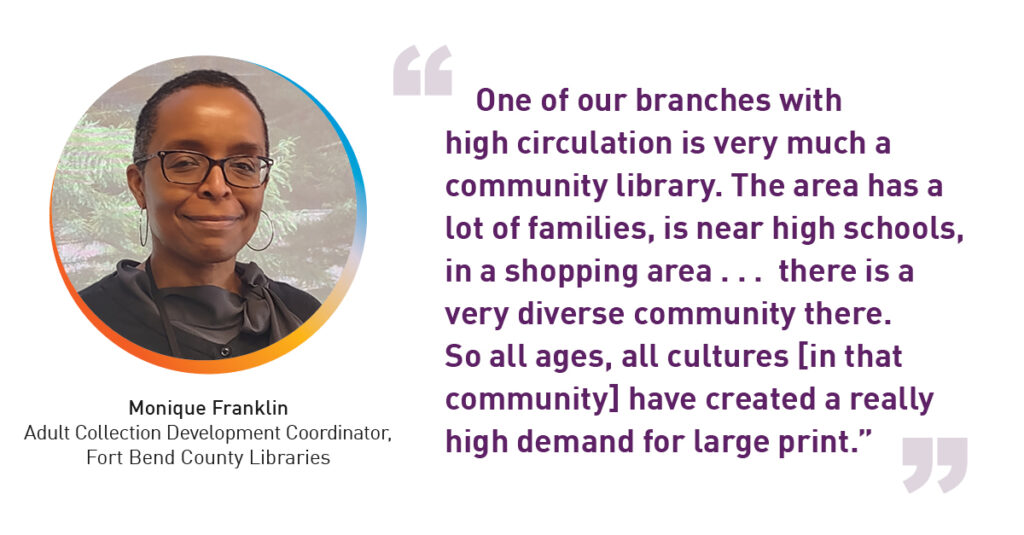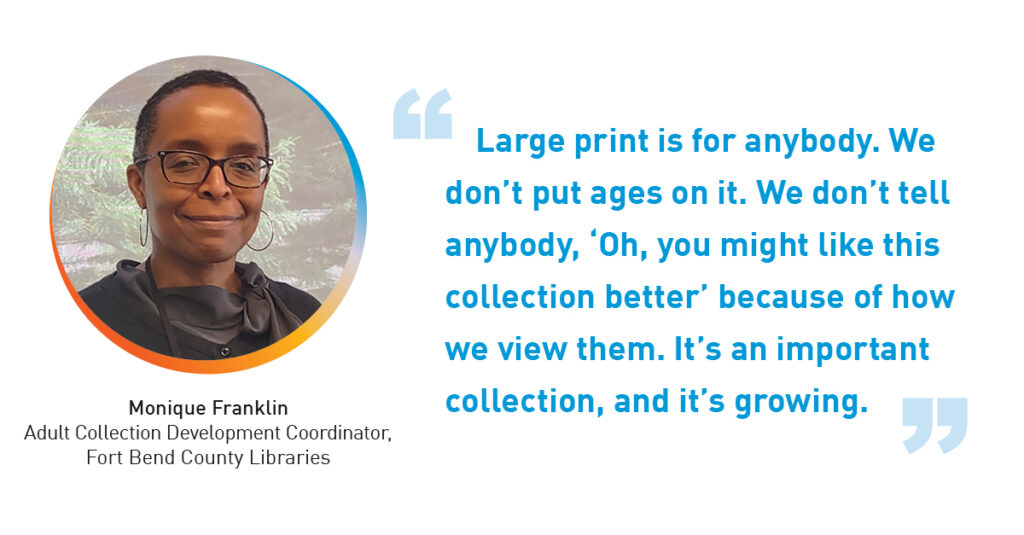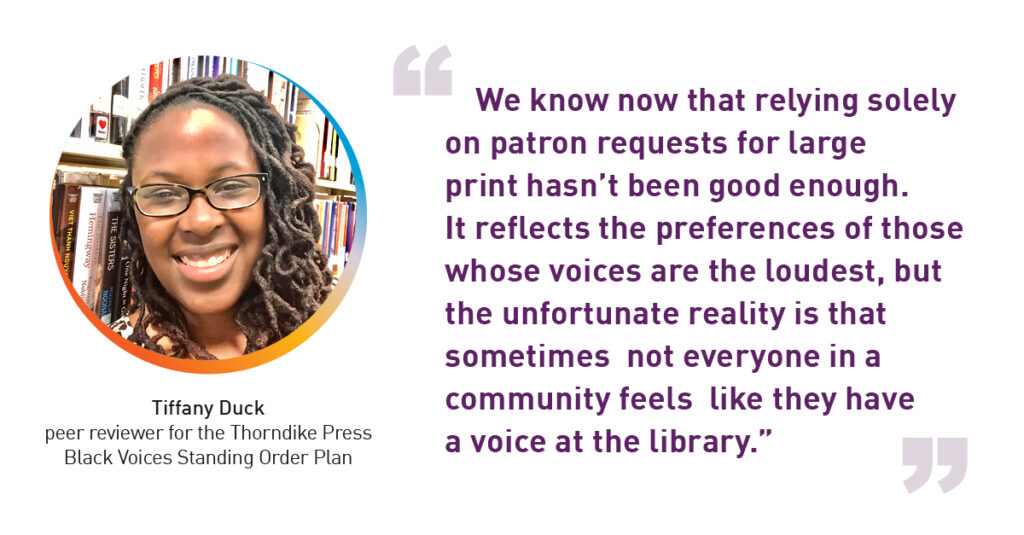| By Heather Booth, associate editor, Booklist |
Patrons of the Fort Bend County Libraries in Texas are adept at using the catalog system to place holds. So much so that Adult Collection Development Coordinator Monique Franklin has used this patron behavior pattern to help shape the collection at each branch. The collection floats, so it’s significantly driven by patterns in patron holds but also gets infusions of fresh titles on a regular basis to pinpoint high-interest titles across fiction and nonfiction genres. They’ve found that the Black Voices selections, titles popular with book groups, and those with social media buzz circulate particularly well.
Franklin finds, through monitoring the patterns of holds, that large print seems to be a preferred format for many of her patrons across neighborhood demographics. “The branches with high circulation [of large print] have commercial areas, apartments, schools, and subdivisions near them. The communities surrounding them have grown a lot in the last 20 years.” Floating the collection based on holds has led to patrons essentially drawing items of community interest into their own branches. “More than half of the large print titles circulating at these branches are from another location.” This patron-driven curation approach naturally creates a neighborhood-library feel. “One of our branches with high circulation is very much a community library. The area has a lot of families, is near high schools, in a shopping area . . . there is a very diverse community there. So all ages, all cultures [in that community] have created a really high demand for large print.” Keeping up with popular nonfiction and ample genre fiction is quite a task. “We try to balance out the number of copies at each branch, but really the demand is so high. We can’t manage the collection based on what hasn’t circulated because you won’t find anything that hasn’t circulated in the last few years.”
Jill Haile, collection development manager at one of the country’s largest library systems in Jacksonville, Florida, agrees that the wide array of large print availability through Thorndike Press® has been a boon to her patrons. “We make very good use of the depth and breadth of their catalog. We look for things that are going be popular to any reader, and what’s so remarkable now is that I can get large print books simultaneously published with regular print, and I can get them in the quantities that I need to disperse throughout our system.” Though her large print readers also place holds with frequency and regularity, in contrast to the floating, patron holds-driven collection composition in Fort Bend, Jacksonville’s libraries have chosen the opposite approach. “I made a determined effort not to float the collections because I wanted each location to have a consistent curated collection.” Haile believes she is better able to balance the collection through direct curation. She monitors and adjusts standing order plans and individual selection to meet patron interest and ensure a good balance at each building across the system. “It has worked out. Each year, we review and adjust what plans branches have, and sometimes we are just trying something new,” Haile explains. Every building gets broadly appealing titles, but these are supplemented with titles of specific interest to each community location. She tests various genres out and moves them within the system based on interest. “We mix it up depending on demand; we’ll reallocate that genre to another location. More titles are placed at larger regional branches that have higher foot traffic and circulation. Population density tends to be higher surrounding these locations, but is not necessarily specific to any one demographic. We intentionally place large print in the system’s midsize to small locations to ensure browsable/holdable content is available. It satisfies the community who knows it exists, but also captures the users who may not know this format. Staff promotion helps find new readers every day.” She finds that this system simplifies the process of tracking demand and adjusting the variety of options as she crafts the ideal balance of large print titles in each location. Both Haile and Franklin rely on these curation tools to keep the newest and most-buzzworthy items coming in for their patrons on a regular schedule. In Fort Bend, Franklin has even seen lesser-known titles from the large print selection become popular with her patrons!
Whether their patrons are reading for pleasure or to support their educational goals; whether they choose large print all the time or just on occasion; whether they first picked up a large print title for its accessibility, reading comfort, or simply because it had the first attractive cover they noticed when they walked into the library; Haile, Franklin, and Vinci’s patrons are committed to the format—just like these librarians are committed to keeping their collection vibrant, fresh, and diverse. Franklin summarizes:
Four Steps to Diversifying Your Large Print Collection
Want to build a more inclusive collection and expand reading options for everyone in your community? Add titles that represent a range of diverse experiences in a more accessible format: large print.
- Set small, quantifiable goals. For example, content by or about underrepresented communities will make up half of all titles in large print displays.
- Open up your selection process to more people. Include input from more frontline staff who work with readers.
- Seek influencers across your community. Look outside the library walls to local leaders in school, religious, book club, or recreational communities; let them be library ambassadors.
- Evaluate your efforts and revisit your goals. Try new approaches, continue what works, and set new goals based on what you learned.
Want to learn more? Watch the webinar.
Ready to reshape your large print collection? Explore Standing Order Plans >>
About the Author
Heather Booth is an associate editor at Booklist. Booth spent the first two decades of her career as a teen services librarian in public libraries.





